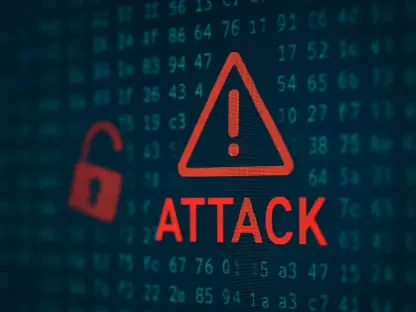In today’s digital world, cybersecurity challenges have grown exponentially as security teams are bombarded with a relentless wave of alerts, notifications, and data from a myriad of security tools. This overwhelming load jeopardizes the safety and efficiency of many organizations. A significant portion of this crisis is driven by the fragmentation of security solutions, as companies often juggle over 30 different vendors for their cybersecurity needs. This flood of information creates what is commonly referred to as “security noise,” delaying risk reduction and leaving organizations vulnerable to cyberattacks. The article delves into these complexities, exploring how AI and automation can help cut through the noise while also discussing the promises and pitfalls these technologies bring to cybersecurity.
The Reality of Security Noise
The Overwhelming Data Deluge
Modern security teams are increasingly overburdened by the sheer volume of data generated by various security tools, making it challenging to focus on genuine threats. A staggering 85% of security professionals report that they struggle to manage this vast influx of information, which often obscures the critical risks that require immediate attention. This deluge of data can paralyze security teams, hindering their ability to quickly identify and prioritize genuine security threats. The resultant delays in recognizing and addressing vulnerabilities compromise the organization’s overall security posture, exposing it to greater risks of cyberattacks.
This situation not only threatens an organization’s security but also strains its resources and personnel. Security professionals find themselves spending excessive time sifting through data, which reduces the time available for proactive threat hunting and strategic planning. The lack of clarity compounded by the data overload can lead to slower response times, increased vulnerability, and, ultimately, heightened susceptibility to cyberattacks. The challenge lies not just in managing this overwhelming data but also in efficiently filtering out the noise to focus on the critical threats that matter most.
Fragmentation and Its Consequences
The reliance on numerous security vendors results in high fragmentation, compelling security teams to manage disparate systems with limited interoperability. This fragmentation exacerbates the challenges faced by security teams, often resulting in inefficiencies and potential blind spots. The excessive noise generated by these multiple, often siloed systems means that critical threats might go unnoticed or be identified too late, leaving the organization at increased risk. Additionally, constant switching between tools and platforms can lead to mistakes, oversights, and missed alerts, further compromising security.
Moreover, the fragmentation of security solutions can lead to duplication of effort, as different tools may generate overlapping alerts for the same issue. This not only wastes valuable time but also adds to the confusion and noise, making it harder to discern genuine threats. The complexity of managing multiple vendors and tools also places a significant burden on IT and security budgets, diverting resources from other critical areas. To effectively combat these challenges, security teams need integrated solutions that provide a unified view of the threat landscape and enable more streamlined, efficient operations.
Embracing Automation in Cybersecurity
The Role of Automation in Vulnerability Management
To tackle the overwhelming volume of data, many security teams have turned to automation to streamline vulnerability management processes. Automation has become crucial in vulnerability management, simplifying tasks such as vulnerability scanning, prioritization, and remediation. Remarkably, 97% of organizations have adopted some form of automation, and 65% specifically use it to boost the speed and precision of vulnerability identification. The ability to swiftly and accurately identify vulnerabilities allows security teams to address issues before they can be exploited, significantly enhancing their overall security posture. However, the adoption of automation in remediation processes remains less common, with only 41% of organizations employing automation to find remediation teams and implement fixes.
Despite the clear benefits of automation, its use is not yet ubiquitous. Some security teams are still grappling with the initial learning curve and integration challenges that come with adopting automated solutions. Furthermore, while automation can significantly speed up the identification and prioritization of vulnerabilities, it does not entirely eliminate the need for human oversight. Experts are still required to interpret the results, make informed decisions, and take appropriate actions. By leveraging automation alongside expert human judgment, organizations can enhance their ability to manage vulnerabilities efficiently and mitigate risks more effectively.
The Mixed Adoption of Automated Solutions
Despite the demonstrated advantages of automation, a surprising 44% of security professionals continue to rely on manual methods for various security processes. This gap in adoption can be attributed to several factors, including lack of awareness, budget constraints, technological limitations, and a shortage of skilled personnel. Smaller organizations, in particular, may struggle with the costs associated with implementing advanced automated solutions and training staff to use them effectively. To fully harness the potential of automation in cybersecurity, these hurdles must be addressed through targeted investments and educational initiatives that highlight the tangible benefits of automation.
Moreover, the adoption of automation is often impeded by concerns over its reliability and the potential for false positives. Security teams may be reluctant to fully trust automated systems, fearing that they might overlook critical threats or generate too many false alarms. To build confidence in automated solutions, it is essential to ensure that they are tested rigorously and integrated seamlessly with existing processes. Providing comprehensive training for security professionals can also help bridge the gap, equipping them with the skills needed to effectively deploy and manage automated systems. By addressing these challenges and promoting a more widespread adoption of automation, organizations can significantly enhance their cybersecurity posture.
AI’s Promise and Challenges
Increasing AI Investment
Security teams are increasingly recognizing the transformative potential of AI in bolstering their cybersecurity measures. Approximately 85% of these teams plan to ramp up their investment in AI over the next five years, underlining the growing importance of this technology. The capability of AI to process vast amounts of data swiftly and accurately makes it an invaluable tool in the fight against cyber threats. With AI’s advanced data processing abilities, security teams can identify patterns and anomalies that would be impossible for humans to detect in real-time, thereby enhancing their ability to preempt and neutralize attacks before they can cause significant damage.
Further evidence of AI’s potential is seen in the attitudes of security professionals. Around 64% view AI as a critical component in their cybersecurity arsenal, and its role in vulnerability assessment, threat prioritization, and remediation is widely acknowledged. Specifically, 38% of respondents believe that AI will significantly improve the accuracy and efficiency of vulnerability assessments, while 30% see it as crucial for prioritizing threats based on their impact and urgency. These figures illustrate the holistic utility of AI in cybersecurity operations and its potential to revolutionize the way organizations approach threat management.
AI’s Role in Vulnerability Management
AI’s integration into vulnerability management processes is viewed with optimism by many security professionals. In addition to enhancing the accuracy of vulnerability assessments, AI can automate the prioritization of threats based on their potential impact, urgency, and likelihood of exploitation. This allows security teams to focus their efforts on addressing the most critical vulnerabilities first, reducing the overall risk to the organization. Moreover, AI-driven analytics can provide deeper insights into emerging threat patterns, enabling proactive measures to mitigate vulnerabilities before they are widely exploited by cybercriminals.
However, while the benefits of AI are clear, its implementation is not without challenges. One significant concern is the integration of AI into existing security frameworks and workflows. Security teams must ensure that AI systems are effectively aligned with their overall security strategy and can operate seamlessly alongside other tools and processes. Another challenge is the potential for AI to produce false positives or overlook subtle but critical threats. To address this, organizations must invest in continuous monitoring and fine-tuning of AI systems, as well as providing ongoing training for security personnel to manage and optimize these advanced tools effectively.
The Paradox of AI Integration
Optimism and Apprehension
Despite the optimism surrounding AI, many security professionals harbor significant concerns about its integration, particularly regarding its impact on software development. A considerable 68% of respondents worry that AI could accelerate code production at a pace that security teams may struggle to match. This rapid development cycle could introduce new vulnerabilities that are overlooked in the rush to deploy software. The dualistic nature of AI, with its ability to enhance cybersecurity while also posing new challenges, creates a paradox that security professionals must navigate carefully to maintain a robust security posture.
Moreover, the potential for AI to be misused by malicious actors adds another layer of complexity to its integration into cybersecurity practices. Cybercriminals can also leverage AI to develop more sophisticated attacks, necessitating even more advanced defenses. This evolving threat landscape means that security teams must stay ahead of both the benefits and the risks associated with AI. Continuous education, robust monitoring, and adaptive strategies are crucial to capitalize on AI’s strengths while mitigating its potential pitfalls.
Balancing AI’s Benefits and Risks
While AI holds transformative potential for enhancing cybersecurity measures, it is essential to acknowledge and address the risks it may introduce. The key to successfully integrating AI lies in striking a balance between leveraging its strengths and remaining vigilant to its potential challenges. Organizations must adopt a holistic approach that includes comprehensive training for security teams, continuous monitoring, and fine-tuning of AI systems, and maintaining a robust framework for human oversight. By taking these steps, security teams can ensure that AI is effectively utilized to enhance their security posture without inadvertently introducing new vulnerabilities.
Furthermore, it is crucial for organizations to foster a culture of continuous learning and adaptation. As AI technologies evolve, so too must the strategies and practices employed by security teams. Regularly updating AI models, incorporating feedback from security professionals, and staying abreast of the latest developments in AI and cybersecurity can help organizations stay ahead of emerging threats. By embracing a proactive and adaptive approach, organizations can effectively harness the power of AI to protect their digital assets and maintain a strong security posture in an increasingly complex threat landscape.
Emerging Frameworks and Future Directions
Continuous Threat Exposure Management (CTEM)
To complement the capabilities of automation and AI, many security teams are considering frameworks like Continuous Threat Exposure Management (CTEM). Unlike traditional periodic assessments, CTEM involves continuous monitoring of IT infrastructure for vulnerabilities, allowing organizations to stay ahead of threats in real-time. This proactive approach ensures that vulnerabilities are identified and addressed as they emerge, rather than waiting for scheduled assessments. By implementing CTEM, organizations can significantly reduce their exposure to potential threats and enhance their overall security posture.
CTEM also promotes a more dynamic and responsive approach to cybersecurity, enabling security teams to adapt quickly to the evolving threat landscape. By continuously monitoring for vulnerabilities, organizations can identify and mitigate risks more effectively, reducing the window of opportunity for cybercriminals to exploit weaknesses. Additionally, CTEM can provide valuable insights into the effectiveness of existing security measures, allowing organizations to make data-driven decisions about where to allocate resources and prioritize efforts. By integrating CTEM with other advanced technologies like AI and automation, security teams can create a robust and adaptive defense strategy that is well-equipped to handle the challenges of the modern threat environment.
Holistic Security Strategies
Modern security teams are increasingly overwhelmed by the massive amounts of data generated by various security tools, making it difficult to concentrate on real threats. An alarming 85% of security professionals report struggling to manage this vast influx of information, which often hides the critical risks needing immediate attention. This flood of data can paralyze security teams, hindering their ability to quickly identify and prioritize genuine threats. As a result, vulnerabilities go unnoticed and unaddressed, compromising the organization’s overall security and exposing it to increased risks of cyberattacks.
This scenario not only endangers an organization’s security but also puts a strain on its resources and staff. Security professionals end up spending excessive time sifting through data, leaving less time for proactive threat hunting and strategic planning. This data overload creates confusion, leading to slower response times, increased vulnerability, and heightened susceptibility to cyberattacks. Therefore, the challenge is not just to manage this overwhelming data but also to filter out the noise efficiently to focus on the most critical threats.









